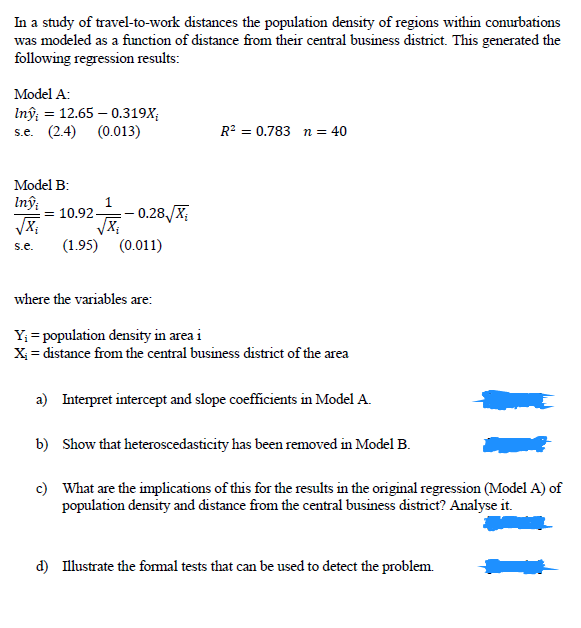In a study of travel-to-work distances the population density of regions within conurbations was modeled as a function of distance from their central business district. This generated the following regression results: Model A: Inŷ; = 12.65 – 0.319X; s.e. (2.4) (0.013) R² = 0.783 n = 40 Model B: Inŷ; = 10.92- =- 0.28,/X; s.e. (1.95) (0.011) where the variables are: Y; = population density in area i X = distance from the central business district of the area a) Interpret intercept and slope coefficients in Model A. b) Show that heteroscedasticity has been removed in Model B. c) What are the implications of this for the results in the original regression (Model A) of population density and distance from the central business district? Analyse it. d) Illustrate the fomal tests that can be used to detect the problem.
In a study of travel-to-work distances the population density of regions within conurbations was modeled as a function of distance from their central business district. This generated the following regression results: Model A: Inŷ; = 12.65 – 0.319X; s.e. (2.4) (0.013) R² = 0.783 n = 40 Model B: Inŷ; = 10.92- =- 0.28,/X; s.e. (1.95) (0.011) where the variables are: Y; = population density in area i X = distance from the central business district of the area a) Interpret intercept and slope coefficients in Model A. b) Show that heteroscedasticity has been removed in Model B. c) What are the implications of this for the results in the original regression (Model A) of population density and distance from the central business district? Analyse it. d) Illustrate the fomal tests that can be used to detect the problem.
Linear Algebra: A Modern Introduction
4th Edition
ISBN:9781285463247
Author:David Poole
Publisher:David Poole
Chapter7: Distance And Approximation
Section7.3: Least Squares Approximation
Problem 33EQ
Related questions
Question

Transcribed Image Text:In a study of travel-to-work distances the population density of regions within conurbations
was modeled as a function of distance from their central business district. This generated the
following regression results:
Model A:
Inŷ; = 12.65 – 0.319X;
s.e. (2.4) (0.013)
R? = 0.783 n = 40
Model B:
Inî:
= 10.92-
- 0.28,/X;
s.e.
(1.95) (0.011)
where the variables are:
Y; = population density in area i
X = distance from the central business district of the area
a) Interpret intercept and slope coefficients in Model A.
b) Show that heteroscedasticity has been removed in Model B.
c) What are the implications of this for the results in the original regression (Model A) of
population density and distance from the central business district? Analyse it.
d) Ilustrate the fomal tests that can be used to detect the problem.
Expert Solution
This question has been solved!
Explore an expertly crafted, step-by-step solution for a thorough understanding of key concepts.
Step by step
Solved in 3 steps

Recommended textbooks for you

Linear Algebra: A Modern Introduction
Algebra
ISBN:
9781285463247
Author:
David Poole
Publisher:
Cengage Learning

College Algebra
Algebra
ISBN:
9781305115545
Author:
James Stewart, Lothar Redlin, Saleem Watson
Publisher:
Cengage Learning

Algebra & Trigonometry with Analytic Geometry
Algebra
ISBN:
9781133382119
Author:
Swokowski
Publisher:
Cengage

Linear Algebra: A Modern Introduction
Algebra
ISBN:
9781285463247
Author:
David Poole
Publisher:
Cengage Learning

College Algebra
Algebra
ISBN:
9781305115545
Author:
James Stewart, Lothar Redlin, Saleem Watson
Publisher:
Cengage Learning

Algebra & Trigonometry with Analytic Geometry
Algebra
ISBN:
9781133382119
Author:
Swokowski
Publisher:
Cengage

Algebra and Trigonometry (MindTap Course List)
Algebra
ISBN:
9781305071742
Author:
James Stewart, Lothar Redlin, Saleem Watson
Publisher:
Cengage Learning

Functions and Change: A Modeling Approach to Coll…
Algebra
ISBN:
9781337111348
Author:
Bruce Crauder, Benny Evans, Alan Noell
Publisher:
Cengage Learning